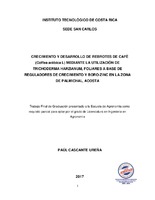Crecimiento y desarrollo de rebrotes de café (Coffea arábica l) mediante la utilización de Trichoderma Harzianum, foliares a base de reguladores de crecimiento y boro-zinc en la zona de Palmichal, Acosta.
Resumen
In order to evaluate the growth of coffee sprouts in response to the application of five treatments such as boron plus zinc, Trichoderma harzianum, NutriPower®®, Gibberellic Acid, the set of Auxins, Cytokinins and Gibberellic Acid plus the Control, were evaluated different variables in the development of regrowth such as stem thickness, stem height, bandola length, number of internodes and number of flowers. This work began in 2016 at the Paraje de Bendición farm located in the San Pablo area, Palmichal de Acosta, San José, Costa Rica; at an average height of 1,475 meters above sea level. A total of 2,880 plants of the Catuaí variety subjected to pruning were used in the month of January prior to the application of the treatments in the last three months of the same year. Each treatment had a total of six experimental units consisting of four rows of 20 plants, each in a total of six blocks. The distribution of the experimental units in each block was randomized. The treatment that showed significant differences in the total of variables with respect to the others was that corresponding to boron plus zinc (B-Zn), followed by Gibberellic Acid (A.G), the other treatments did not show significant differences with respect to the Control.
Descripción
Tesis (Licenciatura en Ingeniería en Agronomía). Instituto Tecnológico de Costa Rica. Escuela de Agronomía, 2017.


